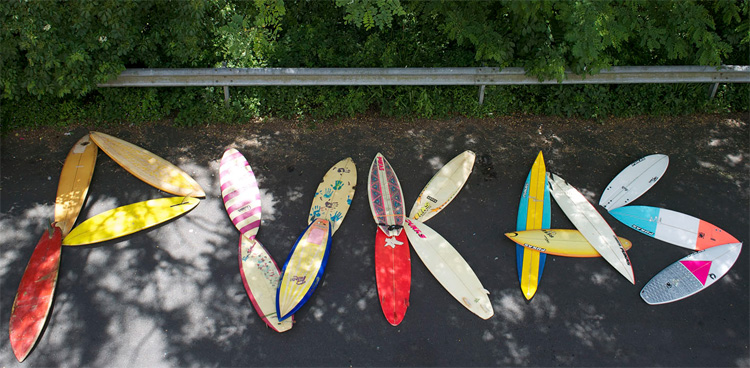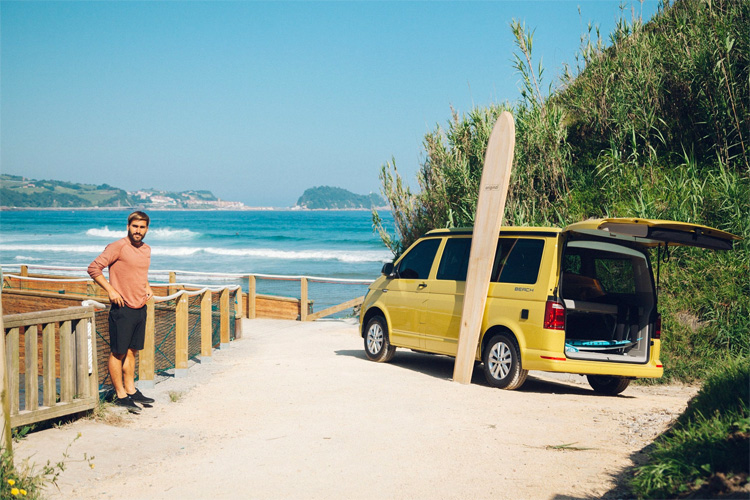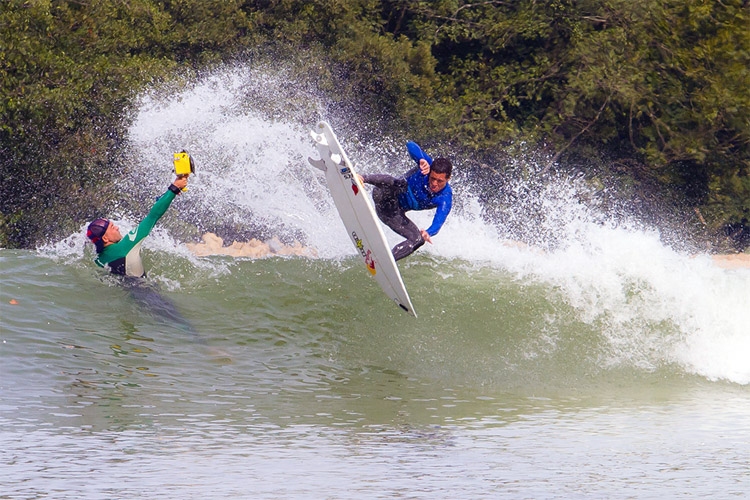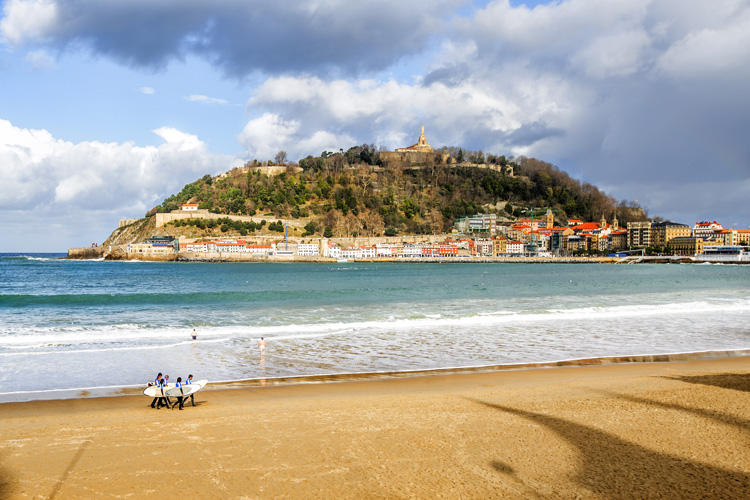San Sebastian's surf cluster is a city-driven, new-generation type of cluster policy that connects apparently unrelated activities around a common theme: surf.
By choosing a theme rather than a specific sector, the cluster initiative refrains from "picking winners" and opens new opportunities for economic diversification that make use of specific local strengths: gastronomy, hospitality, natural urban resources, IT-digital competences and engineering skills.
This case makes clear that nurturing an economy around a theme or lifestyle requires an integrated platform approach, flexibility of intervention, and involvement of stakeholders and unusual suspects.
The findings and lessons from this case are also relevant for cities that want to encourage innovation in transversal themes rather than specific sectors or technologies.
San Sebastian: More Than a Surf Spot
The city of San Sebastian, in the Basque Country (Spain), is famous for its gastronomy, its scenic location, and its rich cultural heritage. But also, it is a great surf spot, and the city is home to many surf-related businesses.
It is not just surf schools and shops: the city is also home to producers of surfboards, special clothing, accessories, and digital equipment.
"We noticed that surf, overall, was a growing business in our city", said Euken Sesé, director of the city-owned development agency Fomento San Sebastian, "and we wanted to make more out of it. That's why we set up our surf cluster policy."
His organization which is 100 percent city-owned, has 50 employees and a total annual budget of about €25m, and develops and implements the city's economic strategy.
Its mission explicitly includes the support to emerging economic clusters in the city, and to forge links between firms and the knowledge institutions. However, for Fomento, "emerging" does not mean "from scratch": the clusters selected must have some roots in the region and potentials in the city.
Surf tourism is now the third largest tourism segment after gastronomy and conference related tourism. San Sebastian's waves themselves are good but not exceptional.
What makes the local surf scene unique is the link with the city: San Sebastian is one of the few European places where it is possible to surf good waves right next to the city center.
This attracts a diverse and mixed crowd that combines shopping, clubbing, eating and surfing. What is the surf cluster policy about, and what is it good for? For Euken Sesé, the main challenge is to connect the dots and stimulate collaboration.
"It was easy to see that surf was becoming a local economic driver, but the industry was very fragmented. We have a number of "old" established players (e.g. surf shops, local board manufacturers), some new entrants (technology companies, surf schools, etc.), and some academic research groups, but there were few if any relations among them."
Hence, the surf cluster was designed with the mission of creating a "co-operation and participation space", a transversal platform for the stakeholders in the sector and beyond to develop a number of competitiveness-enhancing initiatives for its members.
Gaining Trust From the Surf Community
Maite Ayestaran was appointed by Fomento's director as the surf cluster manager.
Her first task was to identify the players in the cluster and engage with them. It proved difficult to gain their trust: there were doubts about Fomento's knowledge about surf as industry and lifestyle.
This hurdle was partly solved by hiring an external expert to support her, but the main change came when she started to learn to surf herself.
"I gained their trust the first time they saw me on the water, and then they started seeing me as one of them". Her advice to any cluster manager: make sure you are credible, engage deeply with companies, make sure you understand their business, otherwise nothing will work".
But there were more hurdles. The surf cluster team had to deal with the very strong competition between players in the sector.
"Some established firms thought that we were supporting new companies against them, and severely opposed the initiative; others claimed a special status within the cluster initiative."
Ayestaran spent much of her time explaining the pre-competitive approach of the initiative, the position of Fomento as a neutral entity, the value of cooperation, insisting on the equal treatment basis of the initiative, etc.
Added Value for the Companies
But after some time, more and more companies took part in cluster meetings, and things started to work out. The design of the surf cluster - i.e. open entry, equitable membership and mixed types of industries - helped to forge new links between seemingly unrelated firms.
As the owner of a surf school explains: "the cluster meetings help us to think about new possibilities, such as teaming up with an IT company to develop an e-commerce solution or to do a project with an engineering school."
One remarkable company in the cluster, Wavegarden, developed an artificial wave technology and sells it worldwide. For them, the cluster is helpful to find new partners within the broad space of the surfing industry.
"In our business - new leisure concepts linked with wave gardens - we need complementary companies that could be part of the whole package, and we can easily meet them here".
For newcomers, the surf cluster helps to find partners. The manager of a new technology company (originally from the skiing industry now entering the surf business) explains: "we relocated here from another region, and the cluster helped to get in touch with local people and better understand the surf business and possibilities ahead."

Engagement with Universities: a Contest for Surf Innovation
There is a lot of innovation going on in surf-related technology: new materials, boards, apps, devices, clothes and all sorts of accessories.
New knowledge and research are needed, but, as in so many other places, there was hardly any connection between the surf business and the local universities.
"So", cluster manager Ayestaran explains, "it made sense to engage with universities as well, we had to find a way to make that connection work".
She got in touch with Florencio Fernandez, professor at the Polytechnic University (University of the Basque Country) and the idea was born to organize a contest for surf innovation, in partnership with three universities and higher education institutions - Mondragon, TECNUM and the University of the Basque Country.
University students and their supervisors were challenged to prototype new surf products (focusing on boards and accessories), and to involve end-users in the process.
It was a big success; more than 100 ideas were proposed by student teams, and the 18 best ones were selected to be prototyped. Many of the participating teams proved to be fanatic surfers themselves, and they loved to work on this.
Here are some examples of prototyped products:
1. Sensors and microchips in the board for use of visually impaired people;
2. A board with a built-in engine;
3. New foams and glass fibre to be used in boards;
The winners gained a support package to set up their own business: privileged access to start-up funds, and the opportunity to closely work with mature companies in the field.
The contest helped to open up the door for co-operation between university departments and surf companies, who never considered it in the past.
In the words of Professor Fernandez: "Now we have companies coming to us, to see what we can do together; [...] moreover, we are now engaging with new people within the University for some concrete surf-related projects."

Training Opportunities
Enhancing training for surf industry professionals is a key achievement of the cluster. The local University of Mondragon offers a Masters program on "marketing and management in surf," that is, in principle, very interesting for surf companies.
But as the course is tailored to regular, full-time Master students, it did not suit the agendas of busy company bosses. To change that, Fomento made a deal with Mondragon to open up some of the more interesting modules of the course for professionals. Employees from companies are now able to attend these modules over six weekends, and 14 already did so.
The World Surf Cities Network: Learning and Selling
As part of the cluster policy, Fomento set up an international city exchange network: the World Surf Cities Network (WSCN) 2, with medium-sized surf cities that also want to make more out of the surf business (cities pay a fee to become a member).
They learn from each other about surf cluster practices, surf-tourism promotion and joint project development. Moreover, the network makes business sense: surf firms in the San Sebastian cluster use the contacts to gain access to new markets, and to find business partners abroad.
Fomento financially supports cluster members if they travel to matchmaking events in the network. It also runs the secretariat of the network.
Not Just the Economy: Smart, Inclusive and Sustainable
Euken Sesé, director of Fomento, is clear about his motives: the key driver to develop the surf cluster initiative is economic development and diversification of the city's economy.
"With our actions, we want to enhance the competitive performance and have new jobs in the surf-related industries in San Sebastian. And it also helps to dynamize the image of the city as a place not just for rich 'pensionados' who love good food".
Yet, there is more than that: one goal is to open up the surf experience to new groups and make it more "inclusive". Supported by the cluster policy, firms have developed surf solutions for blind people (using sensors), children (safety solutions) and elderly people (new types of surf lessons and bundled products).
Thus, surf is developing as a more inclusive sport not just for the young and energetic. Moreover, surf is associated with a healthier and more active lifestyle, and closeness to nature and these are important values for the city.
And, last but not least, there is a close relation between surfing, the carrying capacity of the city's beaches and environmental sustainability - spreading surf and surfing products (e.g. tourism) throughout the year is key to keeping the city's urban quality as well.

Costs and Benefits
San Sebastian's surf cluster policy, as a rough estimate, costs about €250,000 per annum. How does the Fomento leadership know that it pays off?
Fomento has set no quantitative targets or results indicators, but the management team frequently assesses the impact of their actions and the changing situation of the industry.
A first tool is the city's "cluster observatory" that allows them to trace the dynamics of the surf industry over time (new firm and job creation, surf tourism, etc.).
Second, there are frequent surveys of cluster members, to assess their satisfaction with the current initiatives. And last not but least, Fomento's management team uses professional self-assessment methods to critically analyze their own actions and adapt them if needed.
A point of debate is whether companies should pay for being a cluster member. In San Sebastian, membership is free, as long as one is in the surf business and shows willingness to participate in the cluster initiatives.
But many regional development experts, in general, are in favor of membership fees: they would signal commitment, and avoid free riding. A related discussion concerns the role of the local government: how long should it be the caretaker of a cluster, and when comes the point where the cluster organization must stand on its own feet?
This raises questions about the longer term, and whether the cluster would always be dependent on the municipality. San Sebastian goes for the public option, with bottom-up participation, no fees and open access.
Lessons for Other Cities?
Despite the specificity of surfing and the surf economy, this story holds, at least, four lessons for other cities.
First, framing the cluster around a broader theme (surf, in this case, but it could be applied to other domains) rather than around a sector or technology makes it more inspiring and recognizable, and helps to catalyze new relationships and innovation beyond industry silos.
This is critical for the consolidation of new "smart specializations" in cities and regions.
Second, cluster policies can be sparked by "hunches", but these are only a starting point.
Their concrete design and operationalization require a much stronger evidence base, assessing the effective potentials for those activities in the city/region. To this, it is wise to involve old and new players in policy design.
Instead of picking winners, the concrete identification of new economic growth potential should be done bottom-up, by multiple players (established companies, new entrepreneurs, universities).
Local governments can create the conditions for those processes to occur (like in the surf cluster), but should refrain from deciding everything by themselves.
Third, and related with the previous, an important message for city officials and cluster managers is: get out of your office!
Open, frequent and informal communication between the cluster manager and cluster members is essential to design adequate policies and effective actions. Moreover, it also facilitates distributed leadership.
Despite being the initiative taker, Fomento assigned important roles to other external players, namely to the universities, in the case of the surf innovation contest.
Fourth, the case of San Sebastian shows that the value of local products and services can become closely linked with the quality of urban assets, such as the natural and built environment (seaside, beaches, and urban atmospheres).
This is a plea to consider more integrated cluster policies that link economic development with urban and environmental planning in the city.
"New style cluster policy: riding the waves of San Sebastian's emerging surf economy" is a case study paper written by Willem van Winden and Luís de Carvalho for URBACT workstream "New urban economies."
It was exclusively edited for SurferToday.com.
